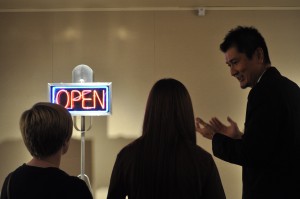
The art department faculty and staff displayed their multifaceted talents in various mediums of art Friday evening at the Juanita Harvey Art Gallery.
Each display was visually stimulating and unique in its own right, and each had its own special story attached as well.
Assistant professor Jennifer Yucus spent three weeks of her summer, teaching a high school art class in Kisoro, Uganda, a city with high levels of poverty and AIDS/HIV cases.
Her display showcased the talents of her young students through color drawings they created. Each piece depicted the everyday life of each student.
The pictures revealed a plethora of scenes including a visit to grandma’s house, the hopes and dreams of what each desired to become in the future, and even what one child hunted after he completed his studies for the day.
Yucus also displayed her own talent for photography and her book blog design.
In March, Yucus will co-host a show with her mentor, Jorge Montero, explaining her new body of works based on her experiences in Uganda.
The art of Suguru Hiraide, associate professor of art and sculptor, explained his critical point of view towards the reaction of businesses after the 2011 earthquake that rocked Japan.
His metalwork sculptures both had “OPEN” signs attached to them, one simulating an earthquake by shaking back and forth, causing the neon sign to shut off.
“In Japan, after the earthquake hit, this was the reaction from most businesses,” he said. “Everything was closed.”
However, not everyone closed their doors for business. According to Hiraide, “pachinko” gambling casinos, the Japanese version of American pinball and slot machines, never even winced after the quake.
Pachinko is a multi-billion dollar business drawing 20 million visitors per year, and the pachinko culture was used as a basis for Hiraide’s second metal sculpture where its “OPEN” sign was surrounded by a constantly moving stream of pachinko balls, signifying that they were not closing for business under any circumstances.
Gary Goldberg, professor of art since 1983, has spent the last 25 years teaching an art class in London.
For the past four years, Goldberg has documented the immense demolition and restructuring of the area of London that hosted the Olympics.
Goldberg said he was amazed with his photographs captured the inspiring moments in preparation and anticipation of the Olympics.
One photograph included in his piece was a panoramic view of Olympic Park and the surrounding area.
“I took the photographs from the 17th story of an apartment building,” Goldberg said. “The panoramic view is actually a merging of three photographs I took and edited in Photoshop.”
Goldberg plans to return to London this summer to document the aftermath of the Olympics and to encompass the legacy of the 2012 Olympic Games.
Elizabeth A. Yarosz-Ash, professor of art and 1991 Hardin Foundation Distinguished professor, displayed her talent in merging science and nature within her paintings. DNA strands, animals, and geometrical design all make an appearance within her intricate works.
According to Yarosz-Ash, it is all about visual balance and harmony.
In one of her displays, dehydrated and flattened flowers were lined up to represent the prime numbers 1-71 with each prime number standing out distinctly in gold leaf.
Each flower gradually grows in size as the numbers increase. Yarosz-Ash is currently working on some new projects, she said, but wishes to keep it a secret for now.
Steve Hilton, assistant professor of art, showed his fascination with nature and its artistic effects in his ceramic display.
Laid out on the floor was a captivating model of a geographic region with mountain islands and bodies of land carefully separated by the flow of water, similar to looking at a large-scale 3D map.
Hilton had a little help from his students and his wife in molding 10,000 ceramic balls that were to form his display.
“The original display actually consisted of 20,000 ceramic balls that were all recycled from another exhibition,” Hilton said. “I like to go green.”
When asked what he had named his display, Hilton shot back with a chuckle, “I call it 12,947…12,948…12,949…”
Hilton has a long list of credentials that also include geologist, and clay artist. He has also taught courses in English, math, history and astronomy.
Catherine Prose, associate professor of art and gallery director, has been with MSU for seven years and chose a unique underlying theme for her fascinating artwork—endangered animals. Prose even has the color-code of a particular animal’s threat level of becoming extinct worked into her paintings in the form of evenly dispersed geometric circles.
“For example, if you see the color red within the circles, it means the animal is critically endangered,” she said.
Prose uses nature as a metaphor to reflect and comment on morals, values and humankind.
Perhaps the most intriguing story came behind the work of Carlos Aleman. Aleman is a graduate of MSU’s art department and is currently the gallery exhibition xreparator and technical assistant.
His artwork consisted of a series of octopi drawings, inspired by both his complex duties within the art department and his 6-year-old son.
“My son is a huge Beatles fan,” he said, “and his favorite song is ‘Octopus’s Garden.’”
Aleman’s wife and son were also there to enjoy the exhibition and to show dad some support.
For three years, Aleman has been an employee of MSU, and is a man of many talents. It took him and a couple other helpers, including Art Department Secretary Jesika Fisher, roughly three days to complete the setup of the exhibition. The atmosphere was extremely sophisticated and relaxed.
Everything from the arrangement of the individual exhibits to the warm, inviting floor-lights that were particularly adjusted to bring out the minute details of each piece was done masterfully.
The gallery itself was a captivating piece of artwork.
MSU has now been accredited by NASAD (National Association of Schools of Art and Design).
NASAD is an organization of schools, colleges, and universities that has approximately 322 accredited institutional members.
In Texas, there are 100 universities, and only 10% make the cut, MSU being one.
The department has made a name for itself and has now brushed shoulders with larger accredited universities like Texas Christian University, University of Texas at Austin, and University of North Texas.
It establishes national standards for undergraduate and graduate degrees and other credentials.
At the event, Ronald Fischli, dean of the college of fine arts, also welcomed the new chair of the Juanita and Ralph Harvey School of Visual Arts, associate professor and art historian Ann Marie Leimer.
The MSU Faculty and Staff Art Exhibition will be on display in the Fain Fine Arts building Monday through Friday from 8:00 p.m to 5:00 p.m. until Oct. 19.
Art Show
September 2012








